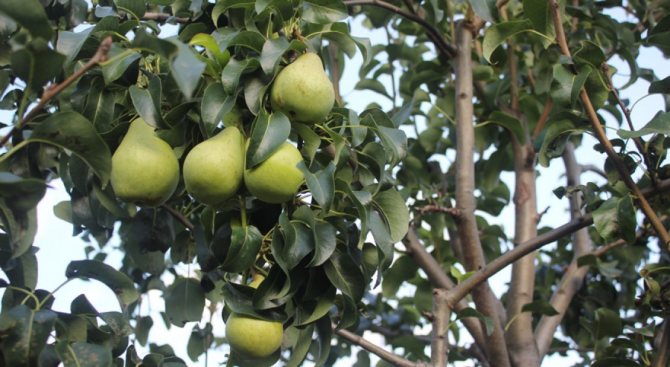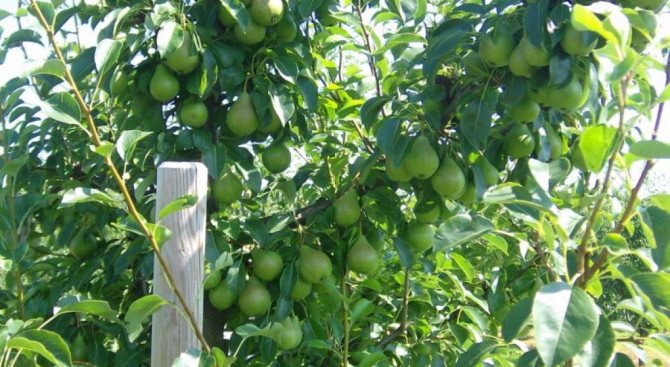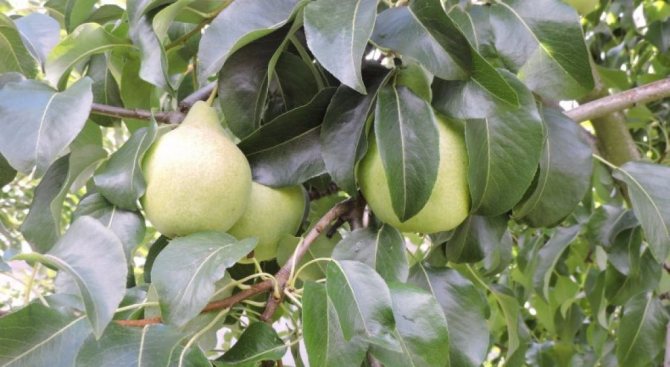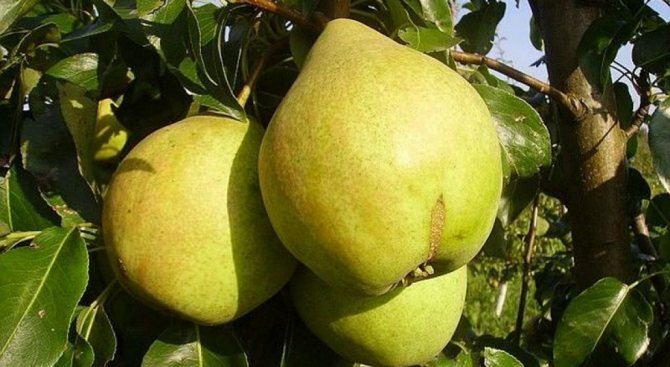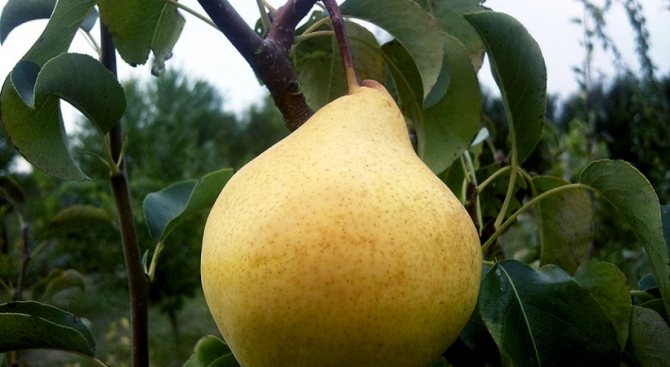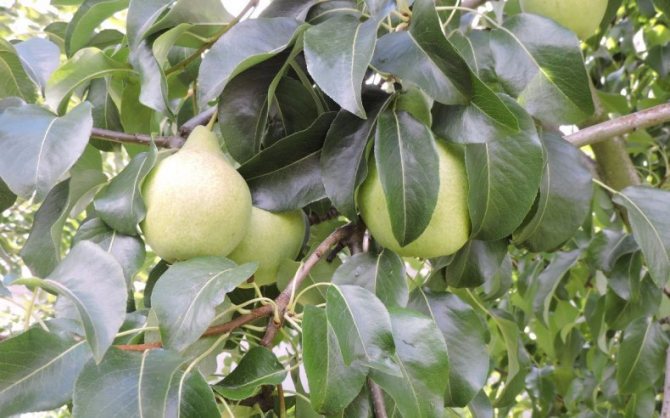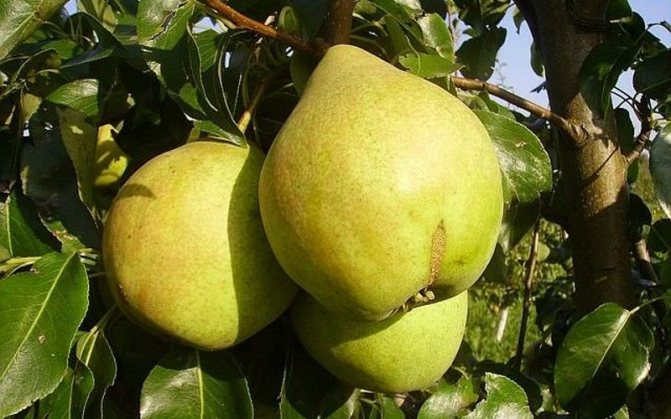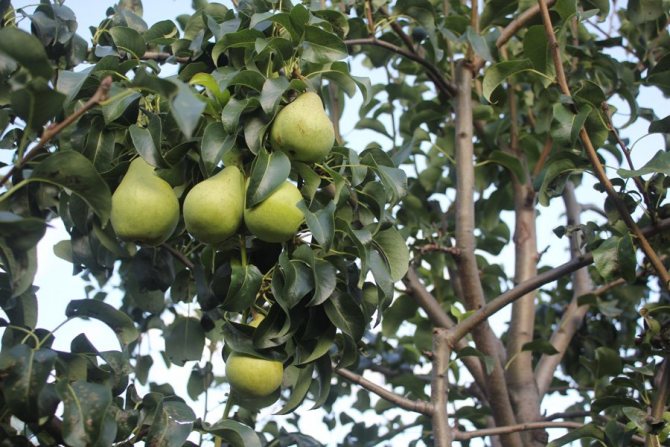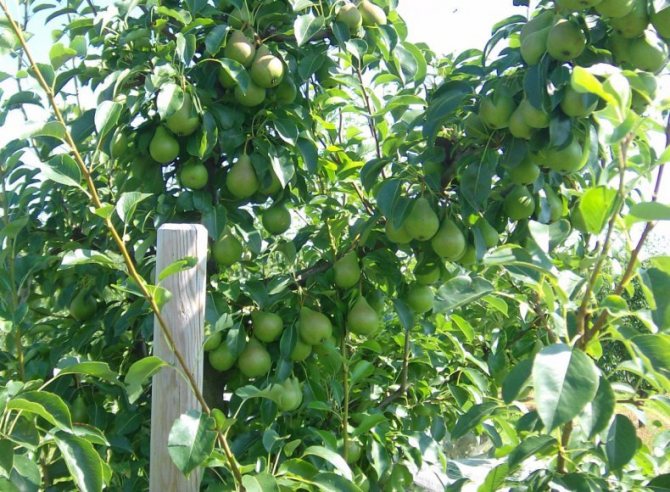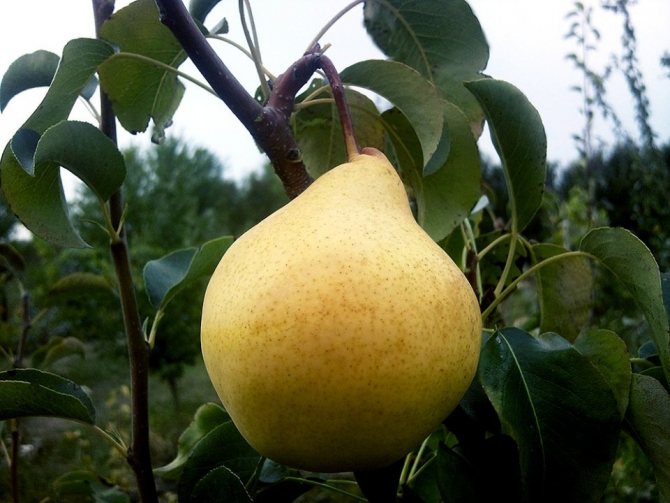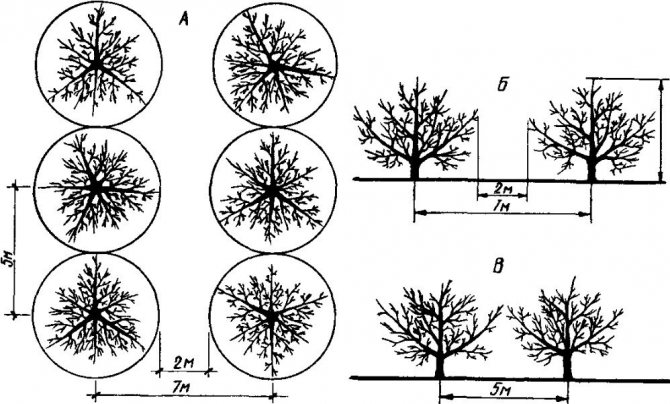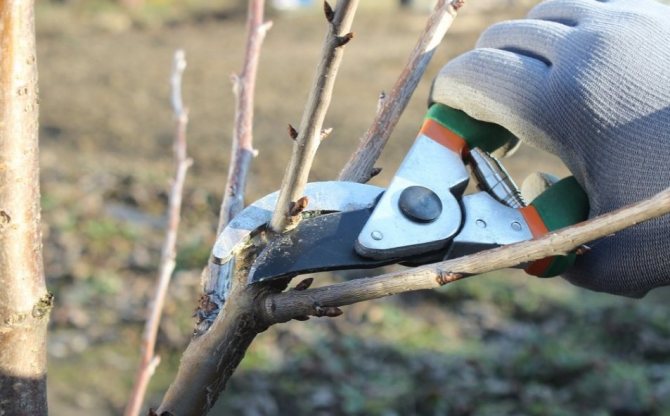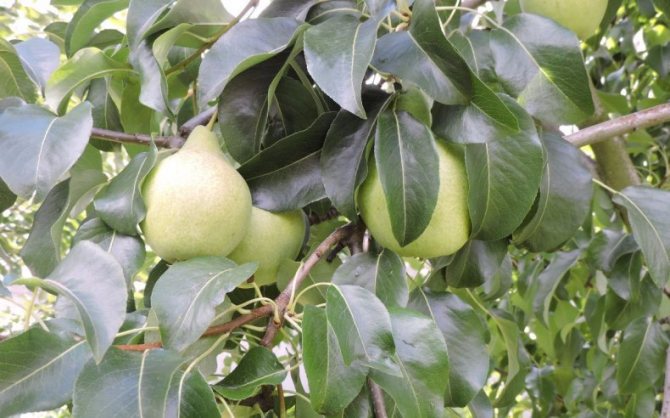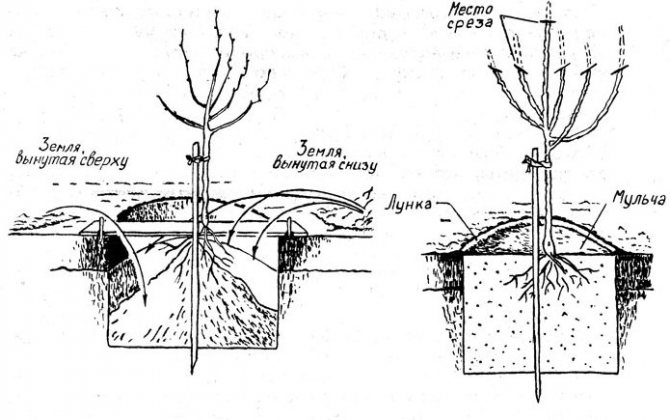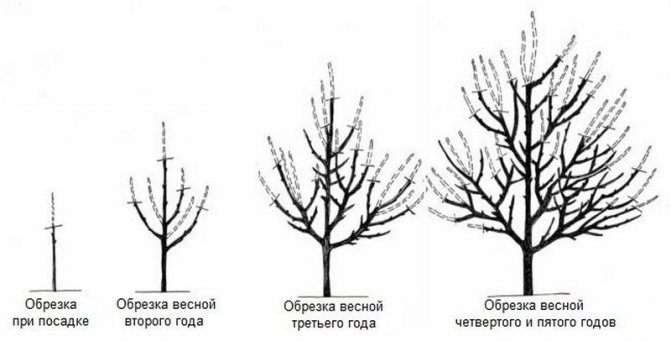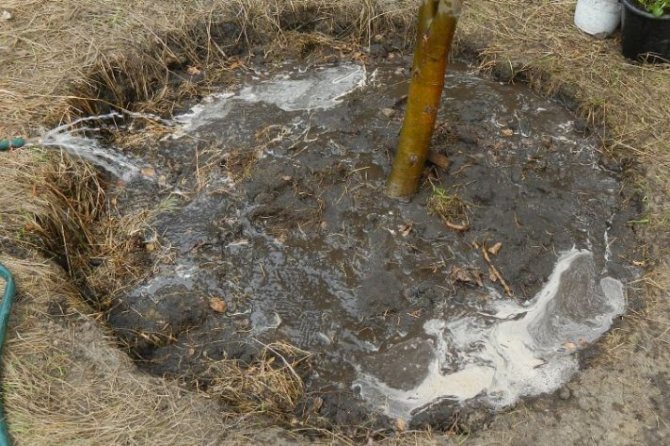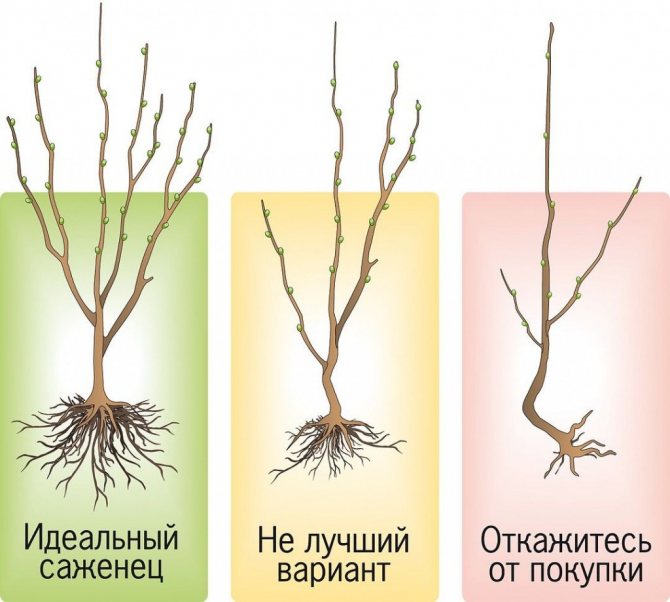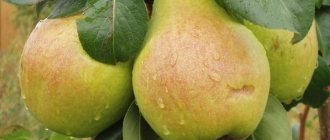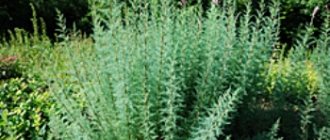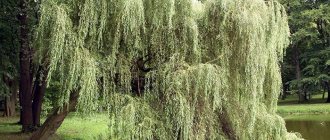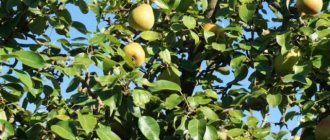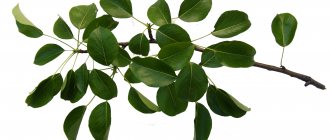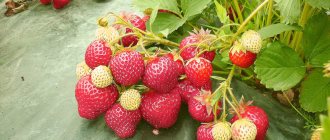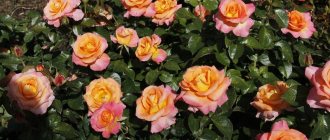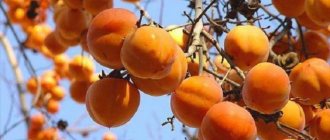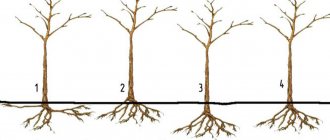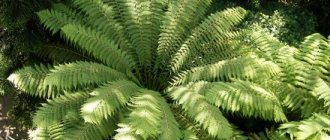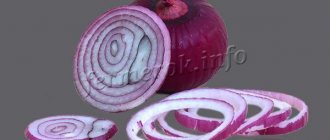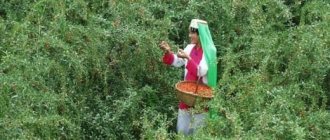The fruits of most late varieties of pears are famous for their sweet juicy pulp, their taste shows a full bouquet that ripens over the summer. They contain more nutrients and vitamins than earlier varieties. One of the late winter varieties is the dessert variety Maria, whose large fruits are distinguished by a long shelf life and a very good taste.
- 2 Planting pear varieties Maria
2.1 Step by step instructions
Description of the variety
Pear variety Just Maria was bred not so long ago. Only in 2010. He belongs to the elite. But it took Belarusian breeders 35 years to create a delicious fruit. It turned out to breed an elite variety due to the fact that they crossed the hybrid 6 / 89-100 and the little-known pear Butter Ro. The name pear Maria received in honor of one of the breeders-creators - Maria Myalik. In the selection garden, the tree began to bear fruit, already at the age of 5 it showed its first fruits to the world. Then the plant was tested for a long time, selected for cold resistance, taste, fruiting quality pear trees. Already in 2003, the pear became an elite. She was transferred to the primary variety study garden, where she was propagated and planted. And in 2005 they gave it to the state for testing.
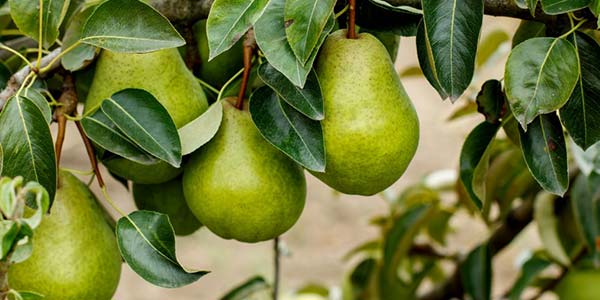
The tree Just Maria with a pyramidal crown has been growing for 10 years. It is medium-sized, reaching a maximum of 3 meters in height, and the diameter of the plant is quite compact - about 2.5 meters. The trunk to the lower branches is about 50-80 cm. The branching is average, and the branches themselves grow upward. Leaves are oval, smooth.
The seedling is unpretentious in care, but it is still worth noting the subtleties for better growth and development:
- Although the variety is shade-tolerant, the seedling will not develop well in constant shade, and this will affect the yield.
- The plant is hygrophilous, needs frequent watering, but moderate, since the soil is heavily flooded, the roots may begin to rot.
- The tree loves warmth, it is worth taking care that the plant is fenced from cold winds.
- For the plant, fertilizing with organic or store fertilizers is required.
Rodents love to feast on the bark of a young seedling, so you need to protect it from them by tying cardboard to the trunk, and securing it with wire from above. In spring, the protection can be removed.
Although the Belarusian variety is winter-hardy, it still does not hurt to warm the root system. After all, insidious frosts penetrate deep into the ground, they are able to kill roots. To prevent this from happening, you can throw a lot of leaves under the ground. They will warm the tree, and when spring comes, they will rot and become fertilizer.
The land around the plant must be periodically loosened so as not to cause oxygen starvation due to the flooded soil.
Region and climate
It's just that Maria is very frost-resistant, which is one of its main advantages. The plant is able to withstand temperature extremes, frost down to -38C °. The main thing is that there should be pronounced summer and winter in the growing area. The fruit plant will take root well in Europe, in most of Russia, some Asian lands. The climate in Moscow and the Moscow region is also quite favorable for this variety. It is advisable that enough snow falls in winter, which will protect the tree cover from hypothermia. But it can bear fruit successfully without it.
The plant is partially self-fertile, because if it grows alone, it will bear fruit, but there will be few of them. It is better to plant nearby trees that coincide in terms of flowering, then the yield will be large. Fruits are formed on small shoots where the buds are not yet sufficiently developed. The average weight of one pear is about 190 grams. But, if Just Maria was well looked after, and the weather was favorable, then the weight can reach 230 grams. The fruit is pear-shaped, rounded. The peduncle is short, of medium thickness, slightly curved. The peel is thin, even, without spots and roughness, a little oily and glossy. Green subcutaneous dots appear. The pulp of the fruit is creamy. When the pear is removed from the tree, its color is greenish-yellow with a red blush. And as it ripens, it becomes a beautiful light yellow color. Pear taste Just Maria is delicate, aromatic, juicy, sweet with pleasant sourness. The consistency is medium and fine-grained. Contains up to 80% sugar. The taste characteristics of the fruit were scored 4.8 out of 5 possible points. The seeds of ripe fruits are dark brown and medium in size. The shape is conical.
Yield
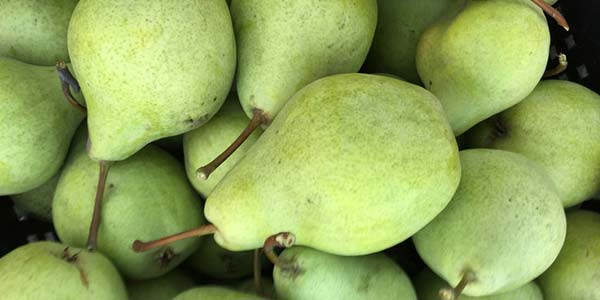

Pear Just Maria is considered an autumn variety, which ripens in October, November. In a cold room, fruits are stored until January. The plant begins to bear fruit as early as 3-4 years after planting. The harvest is annual and large. It is possible to get up to 40 kg of fresh fruit from one tree. "Maria" is very frost-resistant. Even after freezing, the plant quickly recovers and gives a rich harvest.
A feature of the variety is that the fruits are not ripe. This increases the shelf life of the fruit. Pears can remain refrigerated for about 90 days. Ripe fruits are very fragile and soft, which is why they are more susceptible to mechanical damage and early spoilage.
Suitable region and climate
The variety is suitable for growing almost throughout the European part of Russia and partially in the Asian part. The region should be characterized by pronounced seasons, long summers and temperatures no lower than -38 ° C in winter. These conditions are perfectly matched by Moscow and the Moscow region.
Growers also note that there must be enough snow in the region for the cover to protect the plant from hypothermia. But in practice, there were cases when a pear survived thirty-degree frosts and without additional protection.
Dignity
It is worth highlighting the main characteristics of Just Mary, for which she fell in love with many gardeners:
- The tree begins to bear fruit early. A full harvest is harvested as early as 3-4 years of pear life. Other varieties bear fruit only for 5-6 years.
- The pear grows and bears fruit ideally in Moscow and the region, despite the persistent frosts.
- Cold resistance is one of the best qualities of a crop. Maximum at -38C ° the pear is able to thaw, quickly recover and give a large high-quality harvest.
- The plant is resistant to such diseases: scab, black cancer, septoria. Against the background of other pear varieties, it clearly wins, since it has strong immunity, but still you should not forget about protective spraying.
- The fruit tree is compact, which will harmoniously fit into a small home garden.
- But the fruits themselves are considered quite large.
- Many experienced gardeners and amateurs believe that the score of 4.8 for the Just Maria variety is underestimated. The fruits are so sweet and juicy that they surpass the world's best pears: Bosc, Bere, Williams.
disadvantages
There are not many disadvantages of a pear Just Maria:
- When compared with other pear trees, the yield of the Just Maria variety is average.
- If the volume of the harvest increases significantly, then the fruits become smaller.
- If severe frosts occur during the ovary, then the flowers fall off.
But against the background of many advantages, such minor disadvantages simply fade away and are not considered so great. After all, no one is perfect. Belarusian breeders have tried their best.Now every amateur gardener can grow an unpretentious pear tree of the Prosto Maria variety and enjoy delicious juicy fruits from a large autumn harvest.
It's just that Maria is a new variety of Belarusian pears with the fruits of the autumn ripening period. Bred in RUE "Institute of Fruit Growing" (former Belarusian Research Institute of Fruit Growing) through crossing the hybrid form 6 / 89-100 and the variety Maslyanaya Ro. The authorship is assigned to a group of breeders: M.G. Myalik, O.A. Yakimovich and G.A. Alekseeva. Originally the variety was called “Maria”, later it was renamed “Just Maria”. The variety has been assigned the selection number 90-39 / 101. In the conditions of the selection garden, the new hybrid seedling began to bear fruit in the 5th year. In 1996, the seedling was selected for winter hardiness, yield and fruit quality, propagated on a wild forest pear seed stock and planted in the garden of primary variety study. In 2003, the seedling was allocated to the elite, and in 2005 it was transferred to the State Variety Testing.
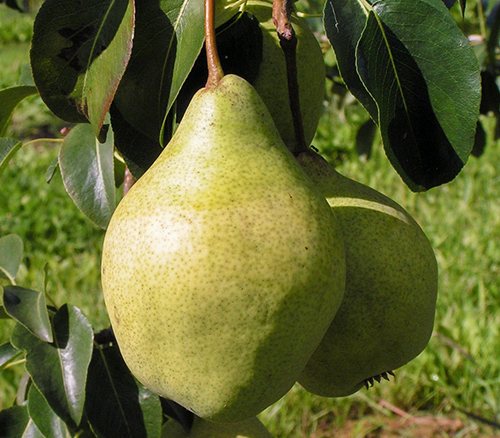

The trees are medium-sized, the crown has a wide-pyramidal shape, the thickening is medium. At the age of 10 years, the trees on the wild forest pear rootstock are characterized by a 3-meter height, the crown diameter is 2.5 meters in both directions. The branches extend from the trunk at an angle close to a straight line, their ends are directed upward. Fruiting is of a mixed type, fruit formations are tied most often on spears, simple and complex ringlets.
The fruits of the pear Just Maria are quite large (the average weight is 180 g, the maximum weight usually does not exceed 200 g, but sometimes it reaches 230 g), pear-shaped in shape. The surface of the fruit is clean, smooth, without roughness and rustiness. The stalks are of medium length and thickness, slightly curved in shape. The skin is very delicate, thin, smooth, dry, with a glossy sheen, oily. Subcutaneous points are numerous, pronounced, green in color. At the moment of ripening, the main color of the fruit is greenish-yellow, the integumentary color is expressed by a dotted pinkish blush. In the period of consumer maturity, the main color of the fruit acquires a light golden yellow color, the integumentary color occupies an insignificant part on the surface of the fruit in the form of a blurred tan with a slight pinkish tinge. Seeds are medium, wide, dark brown in color, conical in shape.
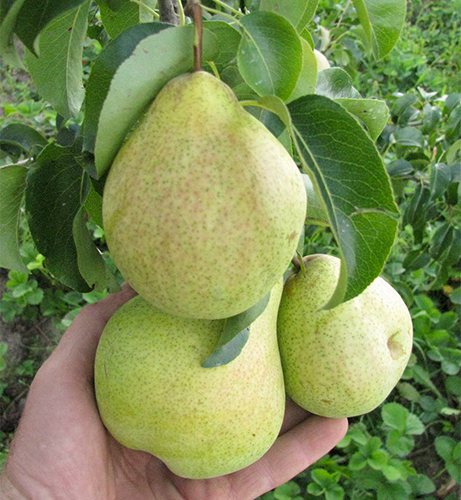

The pulp is yellowish-white, fine-grained in structure, medium density, oily, with high taste - tender, very juicy, with a light pleasant aroma, sour-sweet (sweetness prevails in the taste, sourness is weak, pleasant). According to the Belarusian experts, the taste assessment on a 5-point tasting scale is 4.8 points. Although, according to the opinion of amateur gardeners cultivating this pear, this estimate is even underestimated.
The sugar to acid ratio is very high at 81.5. It allows you to provide fruits with excellent taste even under adverse weather conditions (for example, in a cold summer), as well as with far from ideal cultivation techniques. According to some authoritative experts, Prosto Maria is one of the best pear varieties not only in domestic but also in foreign selection. Many admit that the taste characteristics of the fruits of this pear are superior to such industrial standard varieties from European countries as Williams, Conference, Bere Bosc, Deccan du Comis.
By the time of ripening Just Maria belongs to the autumn varieties. The consumer period lasts from October to November. In the refrigerator, the fruits remain fresh until January.
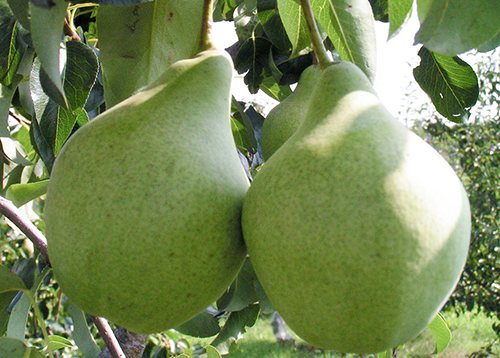

At the time of fruiting, trees enter the 3 - 4 year after planting in the garden. Fruiting is regular. Good yield (up to 40 kg of fruits per tree). Average yield for 2001 - 2005 amounted to 14.2 t / ha, the yield of marketable fruits is 90%, the level of profitability is 89.8%.
The variety is frost-resistant (up to minus 38 ° C), after freezing the trees quickly recover and give good yields. In the winter periods 1996 - 1997. and 1997 - 1998 at sharp temperature changes from positive to negative (from +7 to -33 ° C) freezing of bark, 2-year-old wood and 1-year growth of mother tree did not exceed 2 points. In the conditions of the garden of primary variety study in the winter period of 2002 - 2003. (the air temperature dropped to minus 29.6 ° C) freezing of fruit wood, bark, trunk and 1-year growth was assessed below the control - 1.5 points.
In the conditions of the Nizhny Novgorod region at the end of November - beginning of December 2009, the snow cover almost completely melted, and the process of active sap flow began in the fruit trees (juice almost dripped from the cuttings). By mid-December (14-15), in the absence of snow, the air temperature dropped to minus 31 ° C. Upon further verification, it was found that in most varieties of pears, the level of damage to the core of the wood ranged from 1 to 5 points. Such famous varieties as Chizhovskaya, Nika, Pamyati Yakovlev, Fairy were damaged up to 2 - 3 points. Winter varieties Gera and February souvenir, as well as some southern varieties, are completely frozen. In the Prosto Maria pear, slight damage to the core of the one-year growth (up to 1 point) was observed in the form of darkening of the wood, which disappeared by the middle of the summer period. In the spring of 2010, the tree blossomed, and in the fall it brought a full harvest.
It's just that Maria is resistant to scab, bacterial cancer and septoria.
The main advantages of this pear are early maturity, high fruit quality, yield, winter hardiness, and disease resistance.
The variety is recommended for cultivation in the conditions of Moscow and the Moscow region. The most favorable place for planting is the southern, windless side of the garden plot (house walls, fence), southern slopes. Under unfavorable growing conditions, it is desirable to inoculate with stem and skeleton formers.
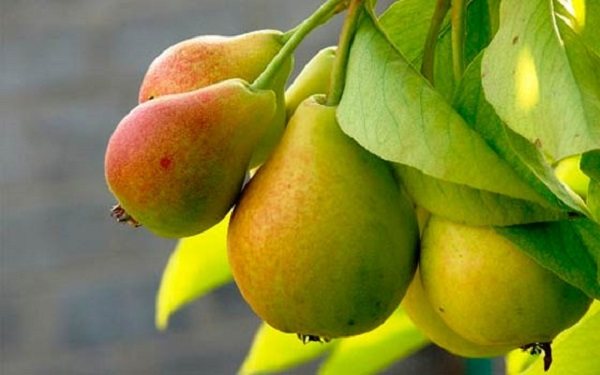

It's just that Maria is considered a new pear variety that ripens at the end of autumn. It's easy to look after her. Thanks to this, the variety is popular among gardeners.
Just Maria is a tree of medium height with a compact wide-pyramidal crown. It is capable of reaching 3 meters. The crown diameter is 2.5 meters.
PEAR "SANTA MARIA, rootstock - pear, 2 years"
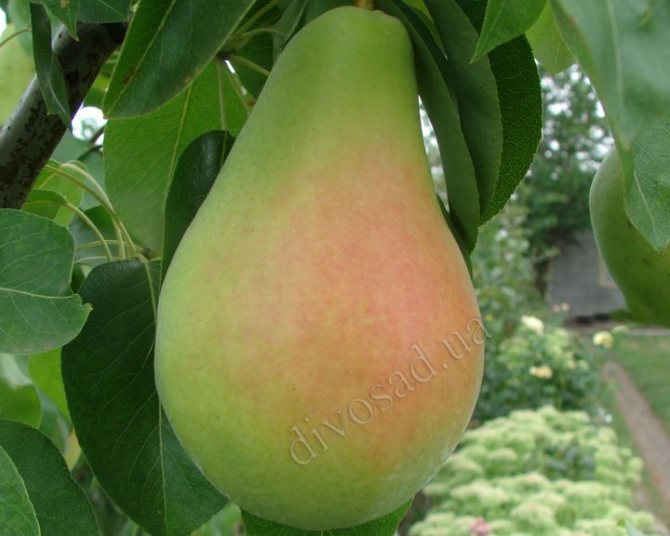

Bred by A. Moretinni by crossing the varieties Duchess Summer and Koschia.
The tree is medium-sized, fast-growing, fruitful.
Winter hardy, scab resistant.
The fruits are large, weighing 200-230 g, elongated pear-shaped, with a blurred pink blush.
The pulp is yellow-white, juicy, tender, oily, without granulation, pleasant dessert taste.
Autumn variety. Harvesting maturity occurs in mid-September. Stored in the refrigerator for 1-2 months.
ADVANTAGES: winter hardiness, early maturity, productivity.
• - Are you interested in this variety? Do you need more information? We are ready to answer your questions.
Write! Call us! Consultation time from 9:00 to 19:00
Pay attention!
Key in importance for rooting plants in a new place are
first 20-25 days
after planting seedlings in a permanent place. The survival rate of young trees and shrubs in a new place and their further development largely depend on timely pruning and regular watering in the first starting three weeks.
Pruning.
Recommended for fruit plants
obligatory pruning.
When planting, carry out post-plant pruning, leaving shoots no more than 40-45 cm long.It is also recommended
annual
removal of dry, damaged or fattening shoots, thinning, crown formation.
Watering.
Young plants DEMAND
regularcorrect watering.
For the successful rooting of a plant, it is important that the soil is moistened not only from above (by 7-12 cm), but to the depth of the root tips of the seedling (up to 35-45 cm). To do this, after landing
during the first month
, it is imperative to water the plant 2 times a week, 1 bucket per tree. In dry weather, it is recommended to increase watering to 1.5-2 buckets of water per plant 2-3 times a week.
Mulching.
For long-term preservation of moisture in the soil, it is advisable to use organic mulching of the trunk circle with a layer of 7-10 cm.
Loosening.
Regular, shallow. Weeding in the trunk circle.
Important to remember!
Lack of pruning during planting and irregular or insufficient watering in the first months after planting significantly reduce the percentage of plant survival in a new place.
Unclassified Divosad.
1. Timing of landing. To achieve successful survival of seedlings, the sequence of actions is quite simple - first, cooling in nature, then, as a result, leaf fall and the transition of plants to the dormant stage, and it is during this period of cold snap and leaf fall - transplanting seedlings. but not in reverse order. So, cooling down to + 10 ° C and below → stopping sap flow → replanting plants. 2. A common mistake is irregular watering. The regularity of watering after planting is one of the most important non-secrets of the survival rate of young plants.
Good luck with your choice.
Divosad
.
Get in group Divosad
not only free consultations, promotions, exchange of experience and support for caring for your plants, but also a friendly circle of friends, like-minded people and a charge of positive emotions.
We really want our group to be comfortable and exciting for everyone who loves a garden, roses, ornamental plants and berry crops.
The history of the appearance and description of the pear Just Maria
It's just that Maria is a pear variety that was bred in Belarus at the Institute of Fruit Growing by crossing a hybrid form 6 / 89-100 and a pear, not very well-known in Russia, Butter Ro.
The authors of the description of this variety and its predominant characteristics were the famous breeders M.G. Myalik, O. A. Yakimovich and G. A. Alekseeva. Initially, the tree was called "Maria", then it was renamed into "Just Maria"... In 2005, this pear variety was sent to the State variety testing.
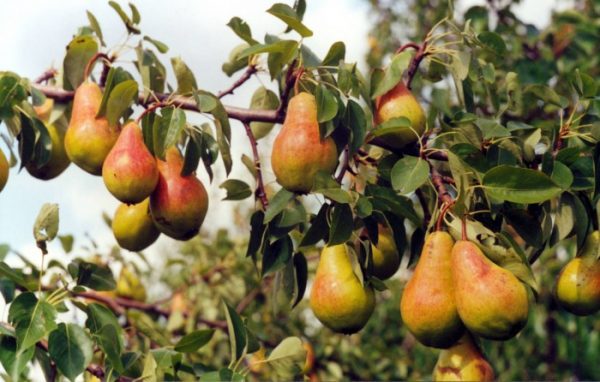

Ripe pears Just Maria on a branch
Pear Just Maria is recognized as a late variety, as it bears fruit in October. And the pear variety Augustovskaya Rosa belongs to the summer. The yield of this variety is not bad, and severe frosts do not in any way affect the quantity and quality of the fruit. It's just that Maria is considered a winter-hardy variety that can withstand temperatures down to -38 ° C. After freezing, the trees quickly revive and bear a lot of fruit.
The fruits of the pear are quite large. The average weight of ripe fruits is 180 g, the largest is not more than 200 g, but in rare cases it reaches 230 g. Pear-shaped fruits. Their surface is clean, smooth and shiny. Fruit stalks are not particularly long and thick, slightly curved. Fruit color is greenish-yellow with pink blush. Planting pollinators next to a pear can seriously increase its yield.
The pulp of the fruit is creamy in color, their density is medium and oily. The fruit is sweet and juicy in taste, has a slight sourness.
Fruit characteristics
It is not in vain that the fruits of the Santa Maria pear are sold in the most elite supermarkets and retail outlets in Russia. They really have incomparable appearance and taste characteristics:
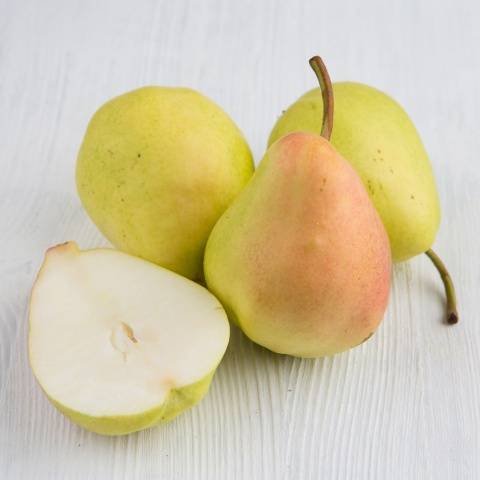

- The shape of the fruit is classic pear-shaped, very regular. Moreover, all the fruits on the tree differ in uniformity in shape and size.
- The size of pears is quite decent, the average weight of one fruit is about 180 grams, but there are also those weighing up to 230 grams.
- The skin is thin, smooth, tender, yellow-green in color with small lenticels.
- The pulp is yellow-white, very tender and juicy, oily, no granularity, really "melts in the mouth".
- The taste of pears is excellent. They are distinguished by a real dessert taste with a slight harmonious sourness.
- The appearance of the fruit is also very attractive - when fully ripe, they acquire a beautiful bright lemon shade. And in those places where the sun's rays directly fall, they leave a pretty blurry pink blush on the pears.
- Fruit preservation is average. According to some sources, Santa Maria pears can be stored for up to two weeks, and according to other sources, up to two months.
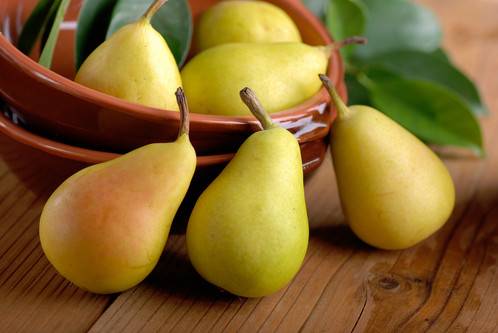

- The transportability of pears of this variety is quite acceptable.
- The use of the Santa Maria fruit is truly versatile.
Read also: The best fertilizers for tomatoes: what nutrition is ideal for seedlings and greenhouse tomatoes, as well as how to get the richest, healthiest and most delicious harvest
The composition of pears includes phytoncides and the most valuable pectin substances. The fruits are very tasty and healthy fresh, they can be used to make various preparations for the winter - jams, marmalades, marshmallows, candied fruits, jams. In cooking, the unique taste of these pears is harmoniously combined with cheese, broccoli and many herbs. Bekmes, a unique healing pear honey, can be prepared from the fruits, as well as used to make various types of cider, kvass, compotes and essences.
Advantages and disadvantages of the variety
The advantages of the variety include:
- fruit taste that prevails over the rest of the varieties;
- the rapid onset of the fruiting period, that is, the harvest is harvested 3-4 years after planting;
- frost resistance - this variety is able to withstand temperatures of -38 ° C;
- It's just that Maria is characterized by increased resistance to most diseases.
Of the shortcomings, only average yield indicators are noted.
Planting pears
The best place for planting seedlings is the windless southern side of the garden.
The pear is planted in the fall when the leaves fall before the onset of frost. Before planting, the seedlings are placed in water for 5-7 hours. When the groove in the ground is ready for planting, they take out the plant. A large hole is dug, its depth is 1–1.5 m. A cone of soil and peat is created in it. The seedling is placed in a hole and the roots are spread over a cone.
Fill the hole with fertile soil, tamping a little... A stake is driven in near the plant, which will act as a support for the future tree. The seedling is tied to the stake with strips of fabric. After planting, the future tree is immediately watered, and the soil around the root is loosened as soon as the soil absorbs water.
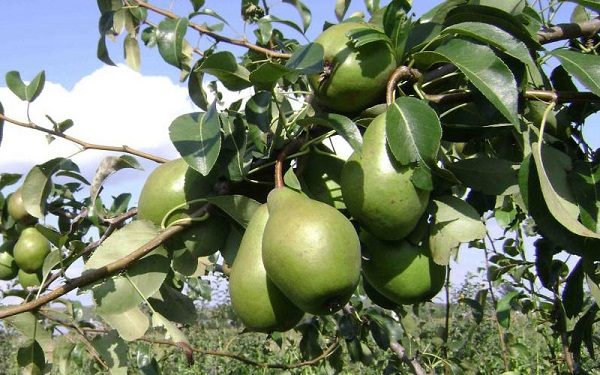

Green fruits Just Maria, ready to pick and ripen in a dark place
Just Maria - an elite pear in your garden
You can plant a pear until mid-October and the beginning of frost, and in the spring - before the onset of a thaw. Pear loves warm and bright places, so she will be comfortable on the south or southwest side of the site. It is necessary to prepare the hole a month before planting the seedling. Pear Just Maria prefers slightly acidic soil, so it must be diluted with a lime mortar containing chalk. This technique will eliminate excess acid and improve the structure of the soil, in which moisture will be better retained. It is enough to carry out the procedure once every 5 years.
Growing conditions
Just Maria normally tolerates shady terrain. However, a long stay in such conditions leads to unhealthy development. Because of this, this variety is grown in areas where there is no shade.
For a tree, a sunny place where the shadow partially falls on the tree is suitable.
Maria just needs moisture, especially in the summer. Therefore, it is necessary to create conditions for abundant and constant watering. Trees are watered not only in the first year after planting, but all subsequent time.... Watering is carried out 4 - 5 times per season.It is worth using about three buckets of water for each tree. After watering, it is necessary to loosen the soil so that air can penetrate to the roots.
Care features
The variety Just Maria needs good care. Otherwise, the tree will get sick, it will grow poorly. In the fall, it can be harmed by rodents. In this regard, it is necessary to wrap the stems of the plant with thick paper after planting.
In winter, the root system of the pear may suffer. Therefore, in the autumn, the tree is prepared for frost. For this, an elevation from the earth is created around the pear Just Mary. In addition, for insulation, you can cover the ground with leaves near the plant stem.
Young trees need:
- Have oxygen access to the root system. Therefore, the pear must be loosened and weeded often.
- Frequent fertilization.
- Continuous application of potassium, phosphorus and nitrogen. Nitrogen is mixed with soil and poured into the groove before the pear blossoms.
- For normal fruit ripening at the end of pear flowering, you need to add a 0.4% urea solution.
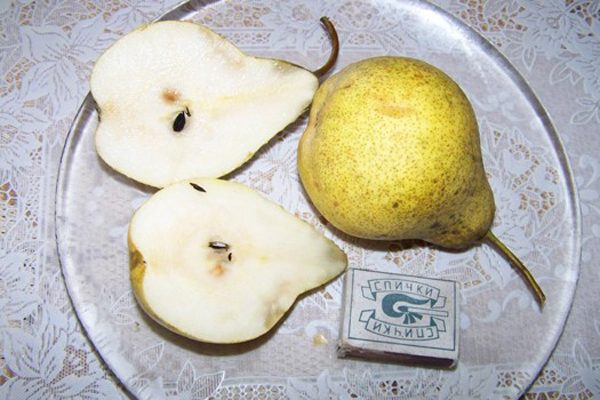

Size of pear cut location
Cold meals and snacks
Rulada jellied chicken roll in jelly3.97 RUBJellied tongue in jelly with vegetable garnishRUB 4.67Beef carpaccio thin slices of beef with spices, garlic, vegetable oil, cheese and lettuceRUB 8.81Trout carpaccio trout slices with spices, garlic, vegetable oil, cheese and lettuceRUB 14.01Fish rollsRUB 8.19Eggplant rollsRUB 6.58Spicy carrotsRUB 0.59Pickled cucumbers3.61 RUBTomatoes with cheese saladRUB 4.26
Harvesting
In terms of harvest time, Just Maria belongs to the autumn varieties. The consumer period of ripeness of this pear lasts from October to November. In the refrigerator compartment, fruits remain fresh until January.
The tree brings its first harvest already in the third year from the moment of its planting. It is possible to collect up to 40 kg of pears from one tree.
Features of the
The fruits are greenish-yellow in color and have a shiny skin. One pear fruit weighs approximately 200 grams. Fruits have greenish subcutaneous dots. The fruit contains small dark brown seeds.
Productivity and storage
The pear of the Santa Maria variety enters the fruiting phase already in the third season after planting. Fruit ripening occurs in September. They can be removed from the branches while still in a solid state, and then they will last longer. From one adult tree, you can collect about 50-120 kg of fruit.
The fruits are perfectly stored in cool conditions for up to 2 months. Since they have a thin and strong skin, they tolerate transportation perfectly.
Santa Maria pears can be used to make juices, preserves, jams, marmalades, jellies, marmalade and other supplies for the winter.
Reproduction
Pear Just Maria propagates by cuttings, layering and grafting. Propagation by cuttings is an effective method, which consists of the following steps:
- Take a green stalk from a ripe pear and placed in a temperature of 20-25 ° C. Thus, the cutting will have roots in a short period of time.
- The selected pear stalk must be with leaves... It is necessary to watch how it will take root.
- A film coating is used to maintain the desired temperature. But here such conditions are created for the cutting so that the air does not overheat.
- To save the cutting from overheating, a damp cloth is stretched over it, which does not shade the pear. Otherwise, the plant will weaken and cannot develop properly.
- In the heat, the cuttings are sprayed with water 5-6 times a day, but only when the sun is shining. On cloudy days, this procedure is carried out 2-3 times a day. Sprinkle the pears until the leaves are completely wet.
- Cuttings in the greenhouse are placed so that they slightly exceed ground level.
For this, heteroauxin tablets can be used. These tablets dissolve in water, in which the cuttings are placed.
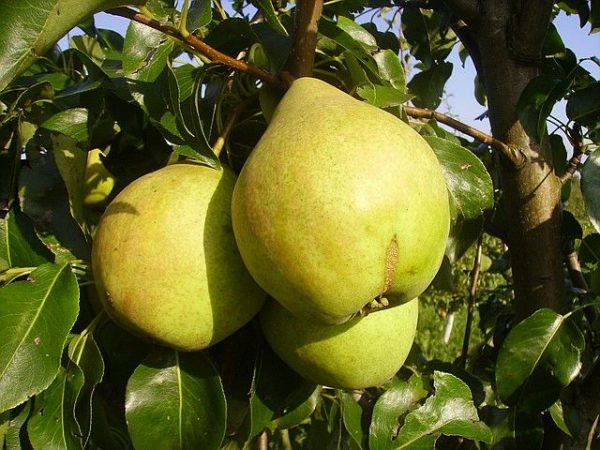

Ripe and juicy fruits of the Prosto Maria pear, ripe in September
Reproduction by layering Is the simplest method. While the pear will take root, there will be no need to observe the natural conditions. For layering, you need to choose the right shoots from a mature plant.
First, the land is prepared in which the shoots can take root. This requires the landing site to receive water and oxygenate. Also, it should not be exposed to light.
When propagating pears, ordinary shoots are used:
- Almost no harm is done to the parent plant when using this method;
- The branch of the plant is covered with soil, only its top remains;
- Roots are formed in a place where the shoot is covered with earth;
- When the roots appear on the layer in the right amount, it is disconnected from the parent plant.
- For effective root engraftment, it is worth taking shoots with a developed ability to form roots. To do this, branches from the tree are cut one year before laying the roots.
Reproduction by grafting - a complex and lengthy procedure. Its essence is to cut off a branch from one plant and graft to another. The tree on which the grafting is done is called the stock.
For vaccination you need:
- From the middle of the crown of a pear, Just Maria, cut off several one-year-old cuttings of such length that three or four buds can fit. This action is carried out at the beginning of December, since the first frost hardens the wood.
- The growths are tied in bunches and placed in the basement. There they will spend the winter.
- The stalk is grafted onto a thin branch.
- The rootstock and the scion must be the same in diameter.
- A rootstock cut is made three centimeters.
- For good survival, the scion and stock are cut at an acute angle.
- After fastening the scion and rootstock, they are wrapped in stretch film and fixed with electrical tape.
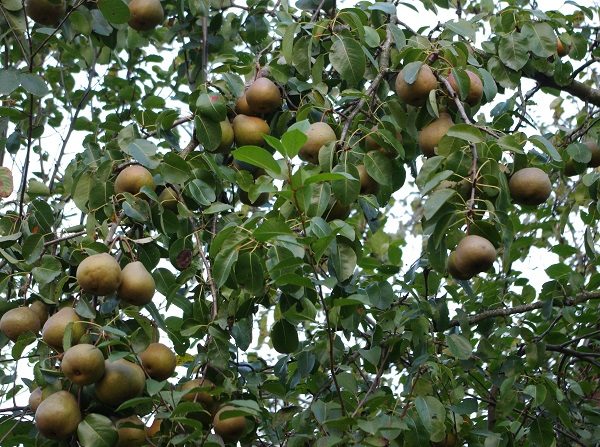

Tree Just Maria with medium yield
Health Benefits of Pears
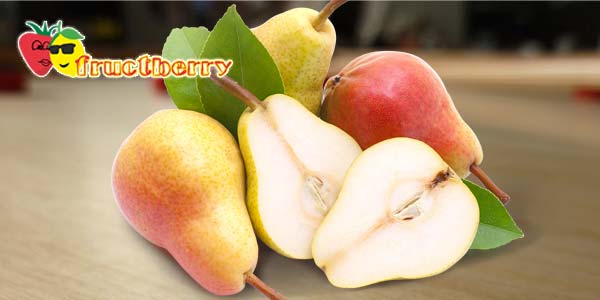

The benefits of pears for the body also lie in the fact that the fruits contain a lot of tannins and organic compounds that have a beneficial effect on the digestion process. The fruit improves the function of the thyroid gland. The vitamins contained in the pear strengthen the immune system.
Women
Experts highlight the special benefits of pears for women. Fruits improve reproductive functions, promote the conception of a child. The acids, which the fruit is rich in, have a beneficial effect on the state of the uterine epithelium. Fruit pulp regenerates the structures of the female genital organs and heals the entire body.
A large amount of folic acid contributes to the successful bearing of the baby and delivery. The expectant mother needs to regularly eat 1-2 fruits a day. The fruits should not be abused so as not to cause stool disorders. You can continue to eat delicious fruits during lactation. But in this matter, it is better to limit the amount of fruit. Otherwise, the baby's tummy will begin to swell. You need to be careful with babies and eat fruits very sparingly.
The substances contained in the product strengthen hair, nails, and improve the condition of the skin. The delicacy rejuvenates the body, starts recovery processes and prevents aging. Pear extract is used in many cosmetic products: creams, lotions, masks. Masks and creams cleanse the skin, saturate the dermis with vitamins. But it is worth remembering that masks based on a pear component are not suitable for very sensitive skin.
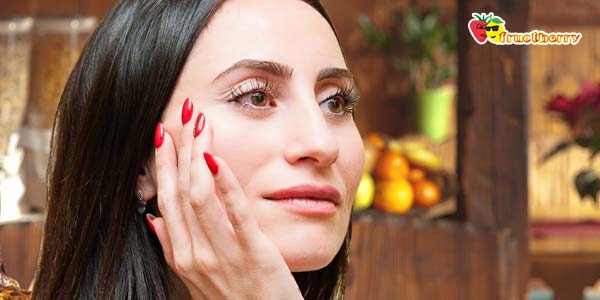

It is beneficial for a woman to regularly, but in moderation, include fruits in her diet. The low calorie content of the fruit allows you to stay slim, which is the advantage of the tasty fruit.
Men
It is necessary to take into account the benefits of pears for men. The fruits provide energy for the whole day and are indispensable for strong physical work and sports activities. The fruit is a source of useful vitamins that improve the functioning of the entire male body.The fruits contain arbutin - a natural antibiotic substance that actively fights viruses.
The use of fruits helps to improve potency. Fruit is an indispensable tool for enhancing an erection. Even in ancient times, men turned to healers - they gave them infusions including pear leaves.
Children
How are pears useful for children? All children enjoy desserts. Low calorie content and a large amount of carbohydrates are the distinctive features of the fruit. Accounting for calories in a pear will help you build a child's diet correctly.
To normalize the intestines, the child can be given a decoction of dried pear fruits. This will help fight constipation.
In the season of colds, it would be good to include pears in the children's menu, so that the body would resist viruses and infections. The fruit improves blood formation and saturates the body with iron.
Diseases and pests
It's just that Maria is resistant to various damage, but the likelihood of infection is still present. In this regard, it is necessary to take measures to prevent septoria, scab and bacterial cancer.
Septoria Is a fungal disease. The spores of the fungus are found in fallen leaves. The appearance of this disease can be determined by the appearance of grayish-brown spots on the leaves. For pear treatment, three garden treatments are carried out. Initially, the plant is treated with a nitrophene solution until the buds open. Then the pear is sprayed at the end of flowering with a solution of Bordeaux liquid. And the last time the tree is sprayed 15–20 days after flowering, also with Bordeaux liquid.
Scab is a fungal disease. The spores are stored in the kidneys. Such a disease can be detected when brown spots are detected on the leaves of a pear and on its fruits. The methods of dealing with scab are the same as for septoria.
Bacterial cancer - the disease is also of fungal origin. Signs of this disease: cracked and blackened bark, brown spots are visible on the leaves, the fruit has turned black. In order to prevent a similar pear disease, damage to the bark should be excluded.
The nuances of culture care
Gardeners rightly point out that the Just Maria pear is relatively unpretentious in care. However, simply planting a tree and forgetting about it, and then regularly harvesting the crop will not work. Abundant fruiting is possible only under the condition of competent agricultural technology. But nothing supernatural is required from the gardener. It is enough to water this pear correctly, apply fertilizers, prune and maintain cleanliness in the trunk circle. In regions where severe winters with little snow are by no means uncommon, preparation for cold weather is also added. After all, it is better to play it safe than then for several seasons to try to reanimate a severely frozen tree.
Watering
Drought Simply Maria tolerates quite well. Therefore, there is no need to moisten the soil as soon as moisture leaves the upper layers of the soil. The first watering in spring is carried out immediately after the substrate has melted enough to loosen it, the second - when the leaves open, the third - just before flowering.
The frequency of watering during the season depends on how cool and rainy the summer is. If there is no extreme heat and drought, three times are enough - in early June, in the 20th of July and in mid-August. The last time Just Mary is watered in the second decade of September. Then watering is reduced to the required minimum. This is necessary so that the pears gain the sweetness and juiciness inherent in the variety and do not crack.
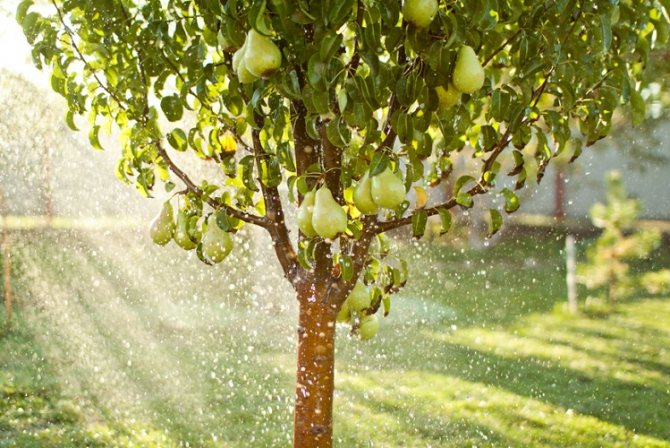

The best way to irrigate pears is with rainfall mimics.
You may also need the so-called water-charging irrigation. It is carried out after the harvest (after about two weeks), if the autumn is warm and poor in precipitation. For an adult tree, 60–80 liters are consumed against the usual rate of 35–50 liters.Such watering helps the pear to properly prepare for the upcoming wintering.
During the first season, the pear seedling is watered weekly, spending about 10 liters per tree.
The most suitable method is sprinkling. The soil must be soaked at least 80 cm deep. The usual rate is 20-30 l / m². Or water is poured into circular grooves about 10 cm deep. Several pieces of them are dug at intervals of 15–20 cm, the latter should approximately coincide with the diameter of the crown.
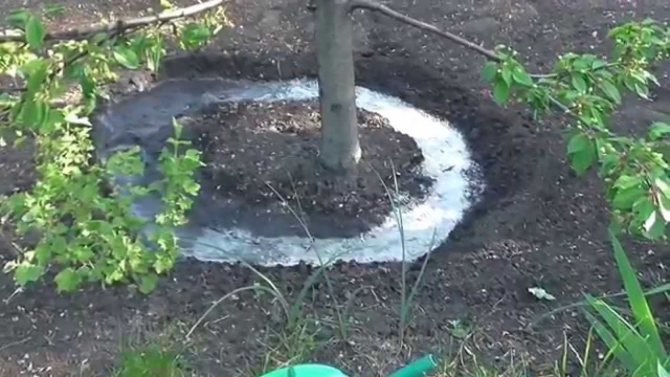

When watering a pear into the furrows, water can be poured into the grooves several times, after the previous portion has been absorbed
Fertilization
Fertilizers begin to be applied in the second season of the pear tree in a permanent place. A planting pit prepared in compliance with the recommendations contains enough nutrients for its growth and development. The fact that the pear needs additional feeding is evidenced by a small annual increase. Normally, for a young seedling, it should be at least 40 cm, for a fruit-bearing tree - about 20 cm.
It's just that Maria reacts very positively to natural organics. At least once every three years, in the spring in the near-trunk circle during the first loosening, it is necessary to distribute humus or rotted compost at the rate of 8-10 kg / m². Mineral nitrogen fertilizers are applied every year. Usually 10-15 g / m² is sufficient. You can distribute the general rate by 2-3 times. In this case, nitrogen fertilizers are applied as soon as the leaves bloom, about a week before and immediately after flowering.
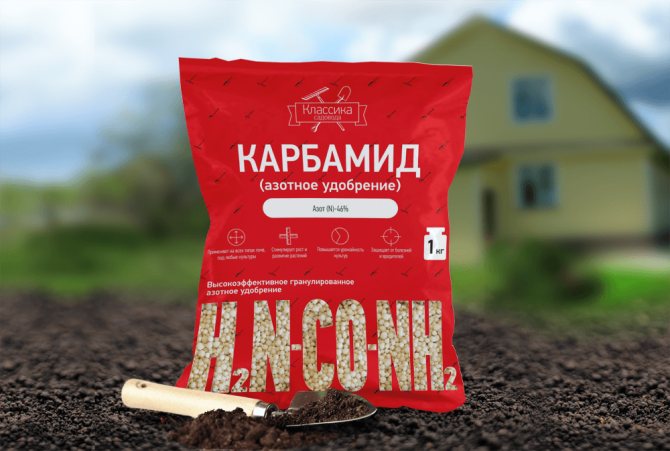

Urea, like other nitrogen-containing fertilizers, stimulates the pear tree to actively build up green mass
It is impossible to introduce nitrogen simultaneously with humus, otherwise the roots of the plant will simply "burn out". The minimum interval between these dressings is 4–5 days.
Approximately 7-10 days after flowering, the pear needs a complex feeding. It is just that both complex nitrogen-phosphorus-potassium preparations (Nitrofoska, Diammofoska, Azofoska) and special fertilizers for fruit trees (Bona Forte, Gera, Agricola, Master) are suitable for Maria. There is also a natural alternative - infusion of fresh cow dung, bird droppings, nettle or dandelion leaves. The norm is about 25-30 liters per adult plant.
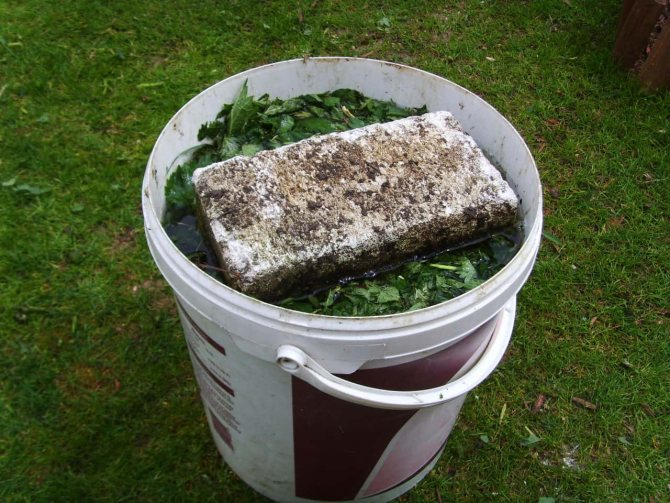

The fact that the infusion of nettle is ready can be judged by the characteristic odor spreading from the container with feeding
Foliar dressing is useful during the summer. Their frequency depends on the state of the pear Just Mary. Usually once a month is enough. Use the same complex fertilizers or a self-prepared solution. Per liter of water take 1-2 g of boric acid, potassium permanganate, zinc sulfate, magnesium sulfate, copper sulfate.
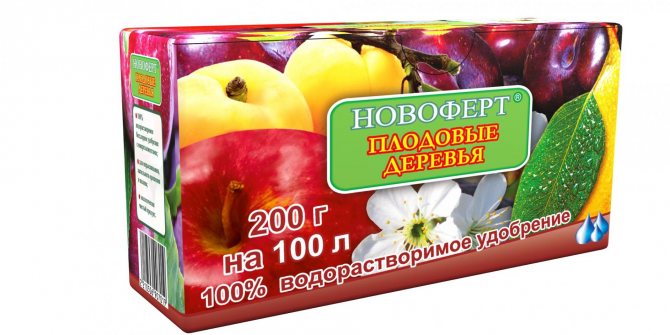

Complex fertilizer for fruit trees contains all the microelements necessary for crops, but the nutrient solution can be prepared independently
Ripening fruits need phosphorus and potassium. For 10 liters of water, take 25-30 g of simple superphosphate and potassium nitrate. There are also special fertilizers without nitrogen content (ABA, Autumn). But you can replace them with ordinary wood ash. Depending on the weather, it is applied dry (it must be embedded in the soil during the loosening process) or in the form of an infusion. Enough 120-150 g / m².
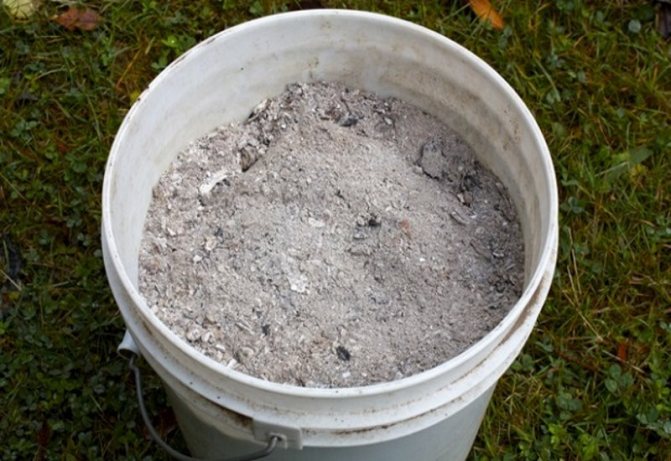

Wood ash - a natural source of potassium and phosphorus
Video: pear care tips
Crown formation
The crown of Prosto Maria is not particularly thickened, the tree is quite compact. Nevertheless, pruning is a must for her. A started pear looks very untidy and does not bear fruit too abundantly.
The main part of the work on the formation of the crown can be carried out both in spring and autumn. In both cases, the outside temperature should be positive. In the spring you need to be in time before the leaf buds "wake up", in the fall - wait for the foliage to completely fall off.
The easiest option for a not too experienced gardener is a sparse-tiered crown. It takes 4–5 years to form it.The finished tree is 3-4 tiers, consisting of 4-5 skeletal branches. The interval between them is 20–30 cm. The height of the tree is limited by cutting off the central shoot at a height of 15–20 cm above the last tier.
Pear formation begins in the second season in the open field. Of the available lateral shoots, 4–5 of the strongest are selected, extending from the trunk at approximately the same, not too acute angle. The rest of the branches are removed to the point of growth. The next year, the second tier is laid over the first. At the same time, 4–5 shoots are left on the skeletal branches of the first order, which have formed in this season. Preference is given to those that grow upward and outward. The overgrowth directed downward or thickening the crown is immediately disposed of. The branch itself is shortened by 10-15 cm. In the third year, simultaneously with the formation of the next tier, the same number of branches of the third order is left on the first.
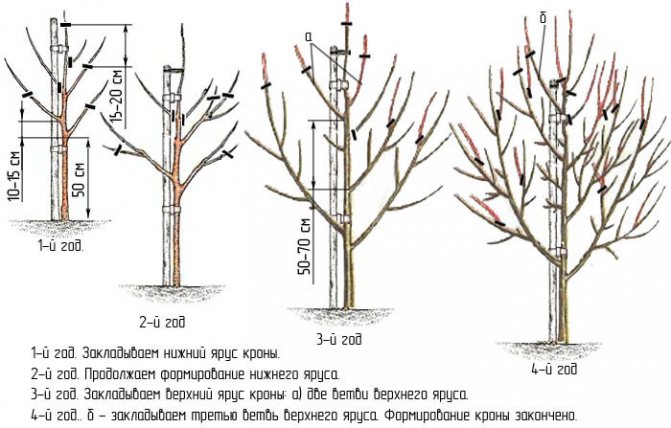

A sparse tiered crown is the easiest choice for a novice gardener starting to form a pear
When the desired configuration is achieved, it only needs to be maintained in the proper form. Every year they get rid of weak, twisted, thickening branches. You also need to cut off the tops - thick shoots directed vertically upward. In principle, they do not bear fruit. But if the winter is expected to be very harsh, you can leave a few pieces as a safety net as a possible replacement for skeletal branches.
If formative pruning is carried out in the spring, nitrogen fertilization should not be applied immediately afterwards. This will negatively affect the taste of the fruit.
Regularly, you need to devote time to sanitary pruning. In the spring, they get rid of all the branches that have frozen over the winter, broken under the weight of snow and ice. In autumn - from those damaged by diseases and insects, dried up. It is not recommended to disturb the tree in summer. At this time, you can only remove tops and individual leaves that prevent the access of light to the fruit.
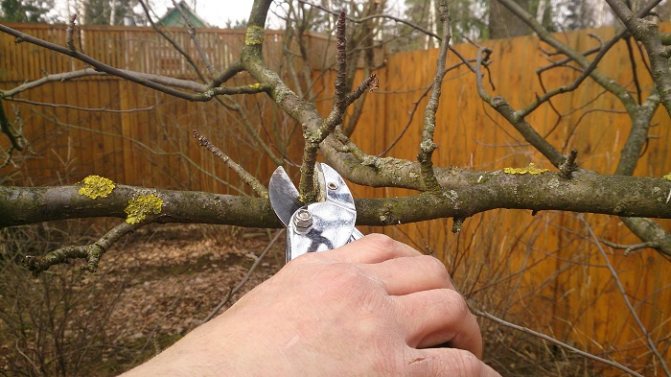

Any damage caused to the pear during the pruning process is a "gateway" for infections, so in no case should you forget about disinfecting instruments and treating "wounds"
Cut leaves and shoots are removed from the trunk circle and burned. It is a very suitable wintering place for many pests and spores of pathogenic fungi.
Video: how to properly trim a pear
Preparing for winter
Frost resistance of Just Maria is such that she will endure winters in the European part of Russia without prejudice to herself. And when growing in the Urals and to the east, you will have to build a shelter.
Preparation for winter begins with cleaning the trunk circle. It is necessary to remove all fallen fruits, fallen leaves, broken branches, and other plant debris. The mulch layer is renewed, bringing its thickness up to 10 cm in the near-trunk circle and up to 25-30 cm near the trunk itself. It is advisable to use humus. Then the trunk is covered with whitewash until the first fork and the lower third of the skeletal branches. It can be either a special store-bought composition or a self-prepared mixture. Whitewashing protects the wood from rodents and sunburn.
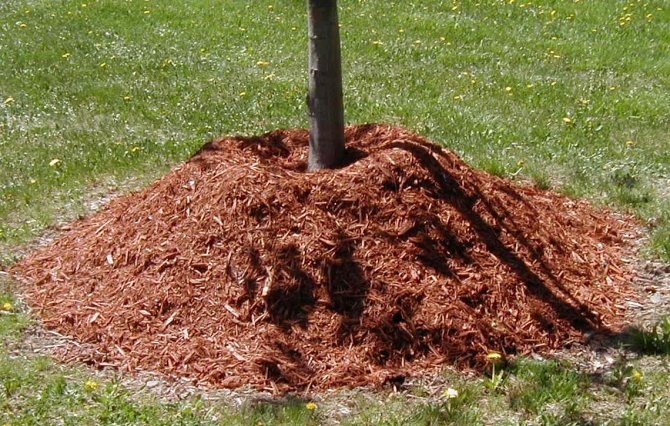

Mulch at the base of the trunk keeps the roots from freezing in winter
Then the base of the trunk is wrapped in several layers of any covering material that must be air-permeable. Polyethylene is categorically not suitable. It can cause preheating of the root collar. But old nylon tights are a good option.
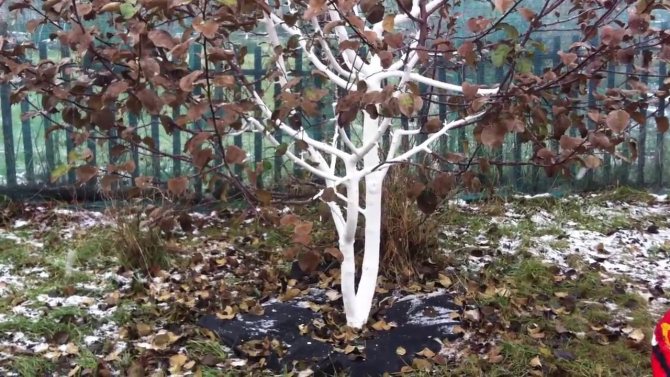

Whitewashing protects fruit trees from rodents and sunburn
For young seedlings, if the dimensions allow, you can simply tie the branches and put cardboard boxes of a suitable size on top, stuffing them with shavings, sawdust, and scraps of paper. There are also special covers for fruit trees and berry bushes. And for more or less tall pears, you can build something like a hut by covering a frame made of poles with several layers of burlap or the same covering material.
As soon as enough snow falls out, it is scooped up to the trunk.During the winter, the snowdrift gradually settles, so it will need to be refilled a couple of times, while simultaneously breaking the hard crust of the infusion on the surface.
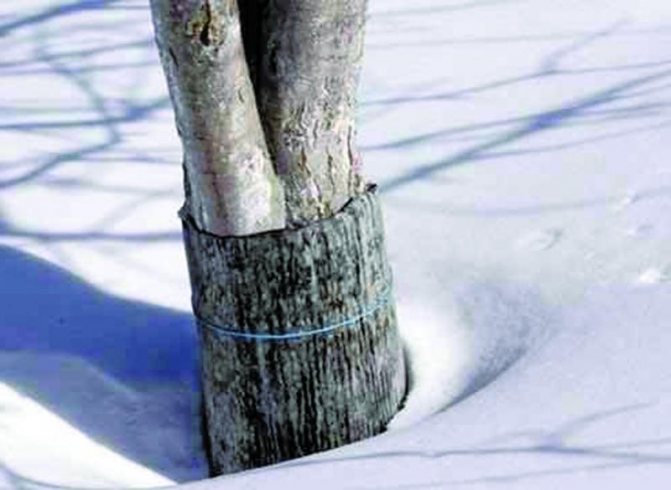

It is impossible to wrap the trunk of a pear for the winter with material that does not allow air to pass through - it is more than likely that it will heat up and develop rot
Video: preparing fruit trees for winter
Prevention of the development of diseases and pest attacks
Prosto Maria's disease resistance is very good, nevertheless, this pear is not completely immune from them, especially if the weather in summer is suitable - cool and rainy. But as a rule, preventive measures are enough to avoid infection.
The best protection against disease-causing fungi is copper-containing preparations. You can use both means tested by many generations of gardeners (Bordeaux liquid, copper sulfate), and new modern fungicides of biological origin (Strobi, Fitosporin-M, Bayleton, Alirin-B). Three treatments are enough per season - before the leaves bloom, about 3-5 days before flowering and 2-3 weeks after harvest.
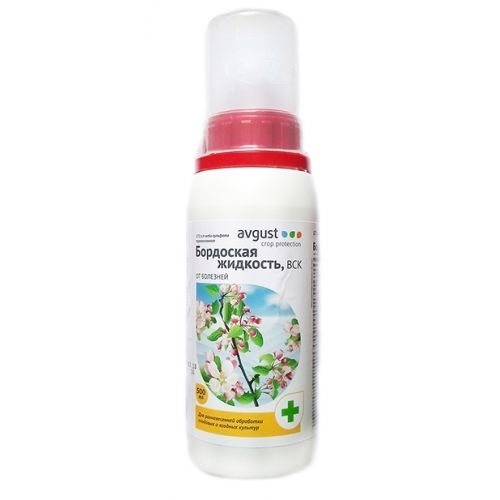

After treatment with Bordeaux liquid, the bark of a pear tree may acquire a bluish tint for a while, this is the norm, and not some kind of exotic disease
During the growing season, you can use folk remedies. The most common are infusion of arrows of onion or garlic, a solution of baking soda or soda ash, colloidal sulfur, diluted kefir. It is enough to spray the tree every 7-10 days. It is useful to periodically add a few crystals of potassium permanganate to the water for irrigation, and add wood ash or crushed chalk to the base of the trunk.
Just Maria has a lot of pests. The greatest danger to it is represented by leafy green aphids, pear honeydew (leaf flies), pear mites, leafworms. Many of them do not tolerate pungent odors, so it is useful to plant spicy herbs in the trunk circle, as well as mint, sage, marigolds, lavender, wormwood.


Marigolds in the garden are not only beautiful, but also very useful
The period of maximum activity of flying insects is the end of May and June. Homemade traps (containers filled with sugar syrup, liquid honey, jam) or ordinary sticky tape for catching flies are hung next to the tree. They are frightened off by the preparations Bitoxibacillin, Entobacterin, Lepidotsid.
If it was not possible to prevent pest attacks, any general action insecticides are used to combat them (Aktara, Aktellik, Inta-Vir, Konfidor-Maxi, Mospilan). An exception is ticks - they are destroyed with the help of acaricides (Omite, Apollo, Neoron). Usually 3-4 treatments are enough, the frequency is determined based on the manufacturer's instructions.
Video: prevention and treatment of pear diseases
Gardeners reviews
Klimenko Irina: It's just that Maria is an incredibly tasty fruit. She can easily compete with southern varieties of pears. At the tasting Prosto Maria is 100% in the first place, since she is characterized by such qualities as yield, frost resistance, resistance to diseases and pests.
Lebedev Anton: I didn't really like the taste of the fruit. It seemed sugary to me. Also, of the shortcomings, I can note the shedding of the ovary during the onset of severe cold weather when the pear blossoms.
Volodonskaya Natalia: I have a pear growing on my site Just Maria. I am pleased that it ripens in the fall and is stored for a long time. Taking care of her is not difficult. The fruit itself is sweet and juicy.
Belarusian breeders have developed a truly unique pear variety. It's just that Maria is adapted to cold winters, and this does not affect the quality and quantity of the crop, she is resistant to tree diseases.
And also from it it is possible to regularly receive fruits with high taste characteristics. Plant a Just Maria pear in your garden and enjoy the aromatic fruits!
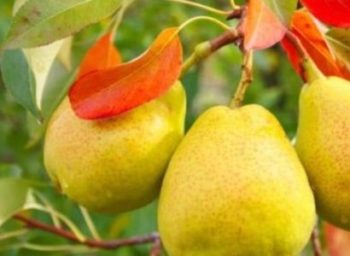

Pear "Just Maria" belongs to new varieties. It fully ripens with the arrival of late autumn.It is quite easy to care for this variety, which led to its extensive distribution among inexperienced gardeners, both at home and in Russia.
Reviews of the results of cultivation
The breeder authors gave the seedling 4.8 points out of 5, but the gardeners' reviews are more enthusiastic. People put "Just Mary" in the line of the most successful varieties. The plant has an extensive list of advantages and a small number of disadvantages.
In addition to frost resistance, good yield and taste of fruits, the pluses include:
- compact size of the tree, the pear will fit even in a small garden;
- unpretentiousness - the harvest can be achieved not only in sunny dry weather, but also in rainy, cool summer;
- immunity to a number of common diseases;
- relatively early onset of fruiting, many breeds, in contrast to this, yield only 5-6 years;
- you can get up to 90% of fruit that is suitable for sale.
As disadvantages, gardeners call the need for pollination, but this is a characteristic feature of many pear varieties. Of the important problems of the breed, there are cases of shedding of ovaries during sudden changes in temperature during the flowering period.
Gardeners who managed to plant this pear variety on their site note the easy rooting in a new place and the rapid growth of the tree. In most cases, the pear began to bear fruit in the fourth year of life, but the first harvest is usually quite modest.
In all its glory, the tree shows itself in the fifth year after planting - with abundant flowering and the formation of a large number of fruits. The pear tolerates frosts well, even with little snowy winters, but in most cases, gardeners insulate it and protect it from rodents.


The pear variety Just Maria has many advantages and practically no disadvantages. It can be grown both in home gardening and in farm gardens. Is of commercial interest. The taste competes with European reference varieties. It can definitely be recommended for cultivation in many areas of the Middle Lane.
Anna Shufrich: “I love the variety Just Maria. I planted it a few years ago, already harvested 2 times. Pears are very tasty, they are stored for a long time and in December are as tasty as in autumn! "
Petr Borodai: “What I don't like most in the variety is that during the return frosts in spring, the ovaries on the pear crumble. As for the taste, it is too lusciously sweet, lacking in acid. But in principle, not a bad view. "
Maria Konko: “The pear variety Just Maria is very interesting, but most importantly delicious. You just can't come off pears - juicy, sweet! Taste comes first, at least for me. It is pleasant to see how it endures winter frosts, does not freeze, even though I do not even insulate the tree ”.
Advantages and disadvantages
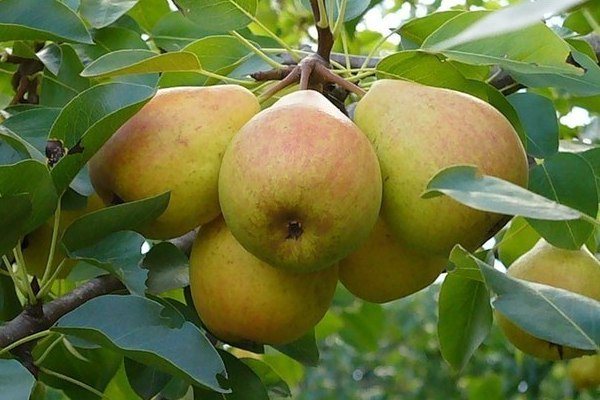

The breeders who bred the variety, and the gardeners who have already managed to plant it on their site, believe that this variety has only positive aspects. Therefore, they are engaged in its cultivation on an industrial scale, and not only in a private garden or plot.
Its advantages include the following factors:
- Early fruiting. Indeed, for a 3-4-year-old pear planting this period is quite early, besides, the first harvest can be obtained in average terms, and not a few pears for the whole tree.
- The yield is about 40 kg per tree, while frost and drought will not affect the yield.
- High frost resistance. Moreover, if she freezes, she will be able to quickly recover on her own.
- Resistance to fungal diseases, such as scab, septoria and some others.
Despite most of the positive qualities, the variety also has disadvantages that it may have. Although those who bred this variety attribute it to an almost ideal look, there are still some pitfalls:
- Although the variety persistently tolerates the fungus, it is still necessary to process the plants, both in spring and autumn, in order to protect them from parasites and various kinds of diseases.The plant can partially resist the fungus, but if the spores begin to actively fill it, it may not stand it.
- It is necessary to carry out regular pruning of the tree, although this culture is compact, the branches can grow a lot, and after a couple of years the tree will not be recognized, and it will be difficult to harvest.
- Not very high yield. The variety wins only due to the fact that the formation of fruits is not affected by weather conditions, since about 40 kg of pears is not so much, especially when the fruits are sent for sale.
- The ovaries may just fall off.
How to correctly plant a seedling
The root collar of the tree must be above the surface of the earth, otherwise the fruiting of the pear will not come soon. Usually gardeners tie the seedling with a rope to a stick using the figure eight method. Before the onset of cold weather, the trunk must be overlaid with spruce branches and covered with a layer of manure, which will protect the seedling from rodents.
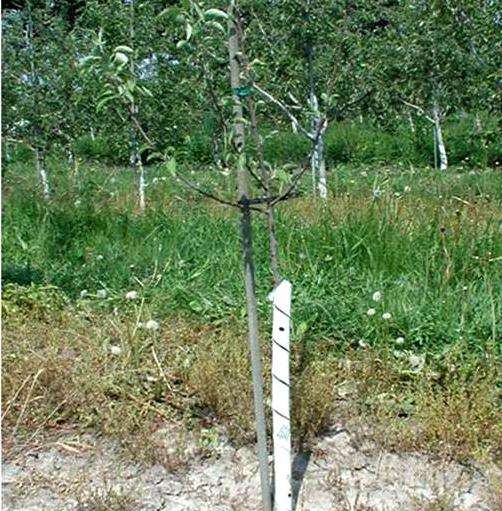

The frost resistance of this species is high, which is important for the northern regions.
Planting and leaving
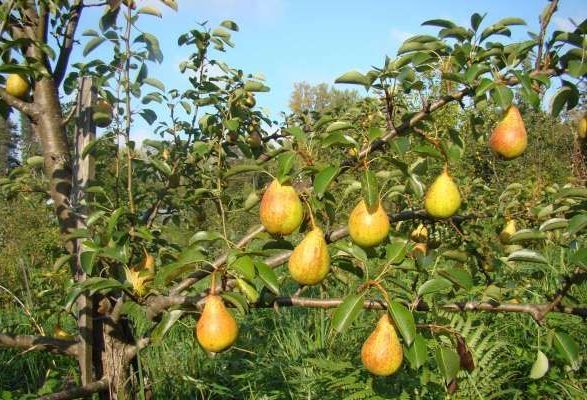

Since this variety is self-fertile, you should take care of planting other trees that can self-pollinate. But besides this, in order to get a good harvest, you need to follow all the rules for tree care.
This variety is quite hygrophilous. Therefore, it is necessary to irrigate the soil not only in the first year after planting, but also after. During the season, you need to do about 5 waterings. At the same time, about 50 liters of water should be poured under each tree. But in order to determine the required amount of water, the following should be done. Take a handful of soil and squeeze. If you get a lump, then less water is needed. But if the soil crumbles, then the volume of watering should be increased.
After watering, the soil should be loosened. This will allow air to penetrate to the roots of the tree.
Mulching
For a pear Just Maria, mulching is required. To do this, use organic mulch. It will help the plant grow faster. Sawdust or humus works well for this. Mulching should be done on time. It is advisable to do this in the spring, when the soil is already warmed up enough. Otherwise, you can get the opposite outcome.
Despite the fact that she has average indicators of resistance to cold, you should arrange for the plant to be well protected before wintering. For this, you can use cotton fabric or newspapers. But if these materials are not available, agrotextile or spruce branches should be used. These materials will not allow moisture to pass through and will be able to keep heat there. Snow can also act as a heater.
The pear requires cutting the main trunk. Thanks to this, the side branches will begin to grow more actively. This should be done in the spring, when the plants are still dormant. You should also cut off the side branches without fruit buds. At the same time, they need to be cut as close to the shoot as possible so that the trail can be tightened. If the branch was cut incorrectly, it is necessary to clean up the area that was damaged.
Top dressing
Top dressing should also be applied in the fall, before the tree begins to bloom. After flowering, nitrogen will need to be added in the spring. Fertilizers are also needed in the fall.
Contraindications and harm
Low-calorie fruits are best avoided in case of exhaustion and anorexia. Common pear can bring not only benefits, but also harm. Hard types of fruits are not recommended in the diet of the elderly; it is better to prefer juicy ripe pulp, which is rich in vitamins and at the same time has a low calorie content.
You can not use the product, despite its low calorie content, with heartburn, diarrhea, dyspeptic disorders, flatulence. The fruit has a laxative effect, enhances intestinal motility. Fruits are not useful for stomach ulcers, gastritis. Discomfort in the abdomen can also occur after the eaten pear is washed down with water. An active fermentation process develops in the intestine, which causes heaviness and accumulation of gases.
Pear is a fruit for a snack. The low calorie content of the product is not able to saturate the body completely. For a complete healthy diet, fruit is best consumed separately from the main food. A person needs to eat one or two fruits a day. Too many pears can cause diarrhea, belching, bowel and pancreatic problems.
The low calorie content of pears will not help to gain weight if children and adults are underweight. People who are lagging behind in body weight need to regularly consume foods with a higher calorie content.
The Santa Maria pear is an early autumn variety. The tree is resistant to cold weather, and the fruits have a delicate sweet taste. In the article, we will consider the description of the variety, the rules for planting and caring for it.
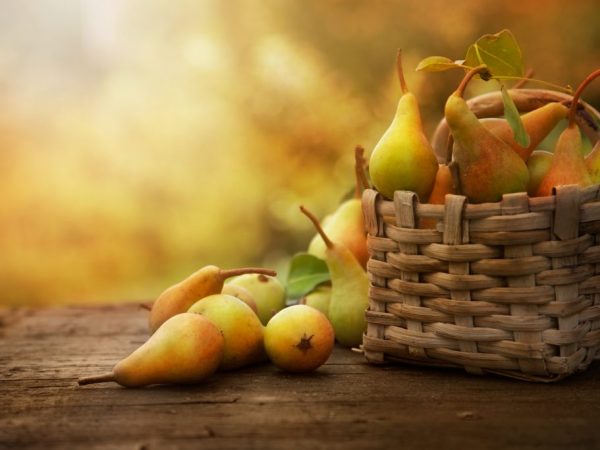

Characteristics of the Santa Maria pear
Gardeners reviews
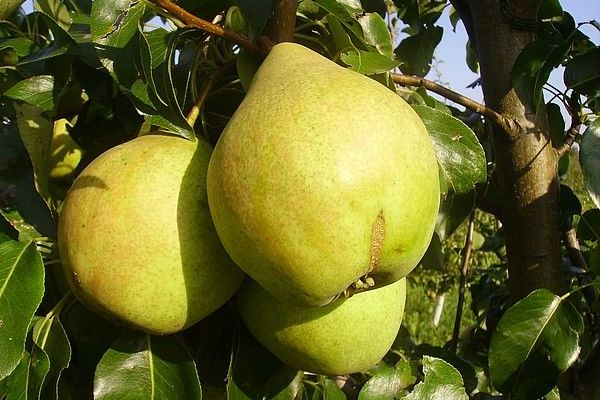

Roman83, Belarus:
The variety Just Maria has been growing in my garden for 7 years, but I can't say anything good about it, almost all ovaries fall off with a separate tree every year. Also, her flowers are too sensitive to spring frosts, for example, this year there are none at all, despite the fact that nearby Williams is red, grafted into the Yurate crown with the harvest.
It also tastes no different, on the contrary, it is inferior to other varieties, in my opinion, sugary sweet, the fruits are large and beautiful, but their keeping quality is low in terms of time, they quickly overripe, in general I will re-graft, the variety is not for everyone.
Doctor-KKZ, Belarus:
I have been growing for 5 years. And two years, in which there should clearly be a harvest, since flower buds differ from ordinary ones, a complete zero. In the previous year, those fruits that set, cracked and rotted. Which is very strange. In the same year, one swollen kidney survived, in March the temperature was +8, and in early April there were frosts at -7, and so it crumbled in the frost. But it is growing too actively. Let's see what happens next year.
Belgorod gardener, Belgorod:
This variety has given me a tangible harvest for the second time. In my opinion, this variety is simply bound to appeal to those who love sweet pears. I love, therefore I completely agree with the 4.8 that the Belarusians give.
With preservation, of course, things are worse, that year a couple of fruits were able to lie for only a couple of months. But this variety was not available for storage from the very beginning.

